Dengcheng Yan
MUSE: Multi-faceted Attention for Signed Network Embedding
Apr 29, 2021


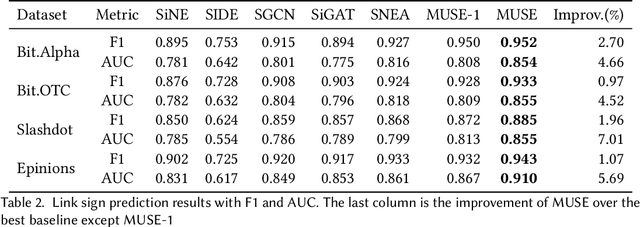
Abstract:Signed network embedding is an approach to learn low-dimensional representations of nodes in signed networks with both positive and negative links, which facilitates downstream tasks such as link prediction with general data mining frameworks. Due to the distinct properties and significant added value of negative links, existing signed network embedding methods usually design dedicated methods based on social theories such as balance theory and status theory. However, existing signed network embedding methods ignore the characteristics of multiple facets of each node and mix them up in one single representation, which limits the ability to capture the fine-grained attentions between node pairs. In this paper, we propose MUSE, a MUlti-faceted attention-based Signed network Embedding framework to tackle this problem. Specifically, a joint intra- and inter-facet attention mechanism is introduced to aggregate fine-grained information from neighbor nodes. Moreover, balance theory is also utilized to guide information aggregation from multi-order balanced and unbalanced neighbors. Experimental results on four real-world signed network datasets demonstrate the effectiveness of our proposed framework.
Hypernetwork Dismantling via Deep Reinforcement Learning
Apr 29, 2021



Abstract:Network dismantling aims to degrade the connectivity of a network by removing an optimal set of nodes and has been widely adopted in many real-world applications such as epidemic control and rumor containment. However, conventional methods usually focus on simple network modeling with only pairwise interactions, while group-wise interactions modeled by hypernetwork are ubiquitous and critical. In this work, we formulate the hypernetwork dismantling problem as a node sequence decision problem and propose a deep reinforcement learning (DRL)-based hypernetwork dismantling framework. Besides, we design a novel inductive hypernetwork embedding method to ensure the transferability to various real-world hypernetworks. Generally, our framework builds an agent. It first generates small-scale synthetic hypernetworks and embeds the nodes and hypernetworks into a low dimensional vector space to represent the action and state space in DRL, respectively. Then trial-and-error dismantling tasks are conducted by the agent on these synthetic hypernetworks, and the dismantling strategy is continuously optimized. Finally, the well-optimized strategy is applied to real-world hypernetwork dismantling tasks. Experimental results on five real-world hypernetworks demonstrate the effectiveness of our proposed framework.
Heterogeneous Information Network-based Interest Composition with Graph Neural Network for Recommendation
Mar 11, 2021
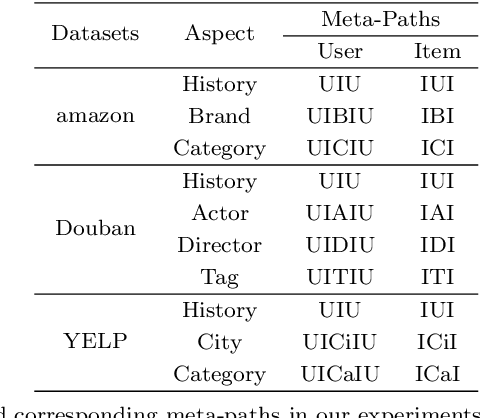
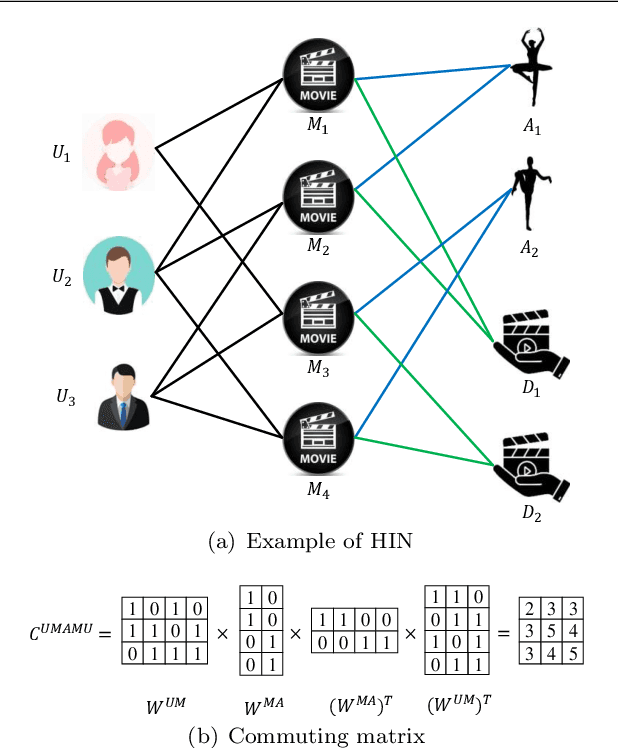
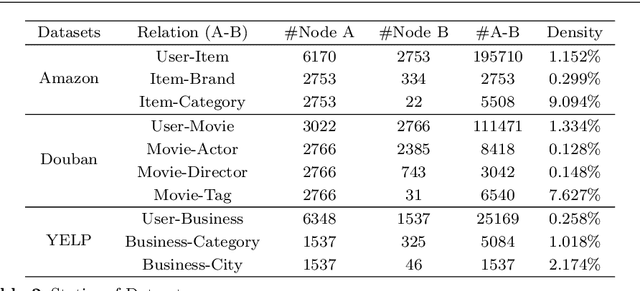
Abstract:Recommendation systems (RSs) are skilled at capturing users' preferences according to their history interactions with items, while the RSs usually suffer from the sparsity of user-item interactions. Thus, various auxiliary information is introduced to alleviate this problem. Due to powerful ability in modeling auxiliary information, the heterogeneous information network (HIN) is widely applied to the RSs. However, in existing methods, the process of information extraction from various meta-paths takes no consideration of graph structure and user/item features simultaneously. Moreover, existing models usually fuse the information from various meta-paths through simply weighted summation, while ingore the interest compositions intra- and inter-meta-paths which is capable of applying abundant high-order composition interests to RSs. Therefore, we propose a HIN-based Interest Compositions model with graph neural network for Recommendation (short for HicRec). Above all, our model learns users and items representations from various graphs corresponding to the meta-paths with the help of the graph convolution network (GCN). Then, the representations of users and items are transformed into users' interests on items. Lastly, the interests intra- and inter-meta-paths are composed and applied to recommendation. Extensive experiments are conducted on three real-world datasets and the results show that the HicRec outperforms various baselines.
Session-Based Software Recommendation with Social and Dependency Graph
Mar 10, 2021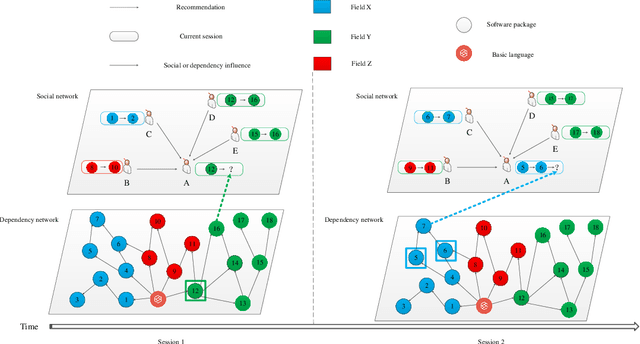
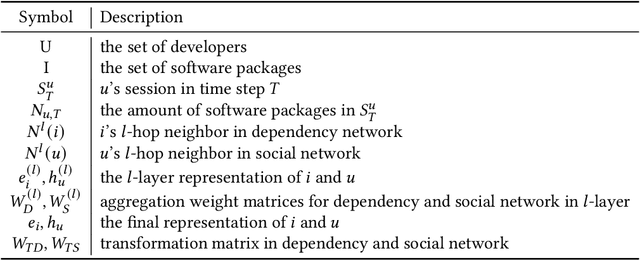
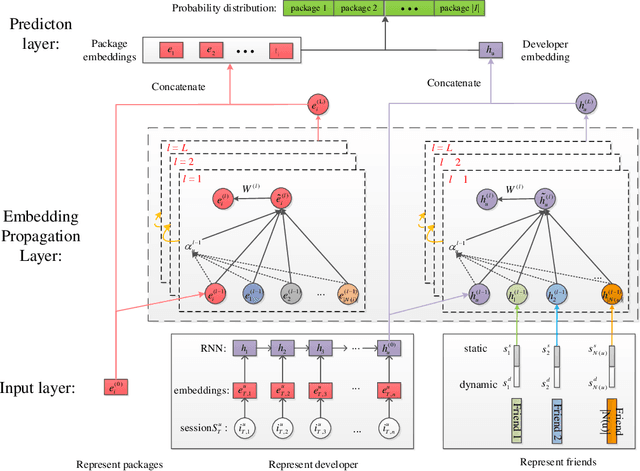
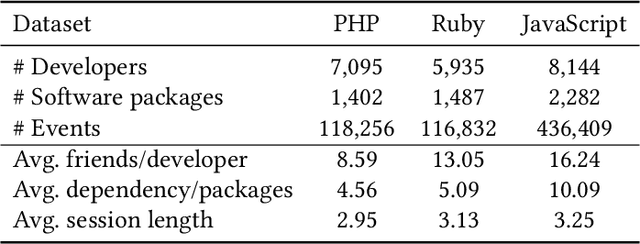
Abstract:Reusing mature software packages that have been developed repeatedly can greatly enhance the efficiency and quality of software development. However, with the rapidly growing number of software packages, developers are facing the challenge on technology choices. In this context, software recommendation plays a crucial role in software development. While conventional recommendation models can be applied to software recommendation, regrading to the unique characteristics of software development, there still remains three challenges: 1) developers' interests are gradually evolving, 2) developer are influenced by their friends, and 3) software packages are influenced by their dependency. Notably, the social influences are dynamic and the dependency influences are attentive. That is, developers may trust different sets of friends at different times and different dependency exhibits different importance. In this paper, we propose a novel software recommendation model, named as Session-based Social and Dependence-aware Recommendation (SSDRec). It integrates recurrent neural network (RNN) and graph attention network (GAT) into a unified framework. This model employs RNN on short session-based data to model developers' evolving interests. In addition, we extend GAT to Social-Dependency-GAT (SD-GAT) for modeling both dynamic social influences and attentive dependency influences. Extensive experiments are conducted on real-world datasets and the results demonstrate the advantages of our model over state-of-the-art methods for modeling developers' evolving interests and the two influences.
 Add to Chrome
Add to Chrome Add to Firefox
Add to Firefox Add to Edge
Add to Edge